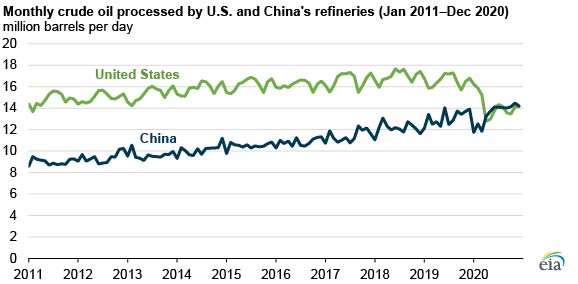
In April 2020, more crude oil was being refined in China’s refineries than in U.S. refineries for the first month on record, and the trend continued for all remaining months in 2020 except for July and August. China processed more crude oil than the United States not only because of the unique effects of COVID-19 pandemic-related restrictions in 2020, but also because of differences in the longer-term structural refining trends between the two countries.
China’s National Bureau of Statistics only reports the country’s processing volume of crude oil. The most direct comparison to the United States is refiner net inputs of crude oil. U.S. refiners also report total gross inputs into distillation units, which include non-crude liquids such as lease condensate and unfinished oils, making gross inputs about 0.5 million barrels per day (b/d) larger than net crude oil inputs. China’s crude oil processing also exceeded U.S. gross inputs in both May and October 2020.
April 2020 was the first full month for the United States in which responses to the COVID-19 pandemic reduced demand for petroleum products such as gasoline, distillate, and jet fuel. Although net inputs of crude oil to U.S. refiners had seen record declines in April, China’s crude oil processing began increasing above previous levels following a demand increase when COVID-19 cases declined in that country.
China’s refinery runs also started to rise in April 2020 partially because China implemented a policy in 2016 that encourages refiners to refine more petroleum products by fixing product prices at $40 when the Brent crude oil price falls to less than $40 per barrel (b). The Brent crude oil price fell and remained less than $40/b between March and May 2020.
While China processed a record 14.1 million b/d of crude oil in June and further rose to 14.5 million b/d in November, U.S. refinery runs have not yet returned to their March 2020 levels because of a combination of demand reductions and hurricanes in the fall that disrupted refinery processes. Hurricanes Laura and Sally in late August and September, respectively, and Hurricanes Delta and Zeta in October resulted in refinery shut-ins on the Gulf Coast, where more than half of U.S. refining capacity is located. Although some refineries came back online in late 2020, U.S. refinery runs remained lower than historical averages in 2020.

Follow us on social media: